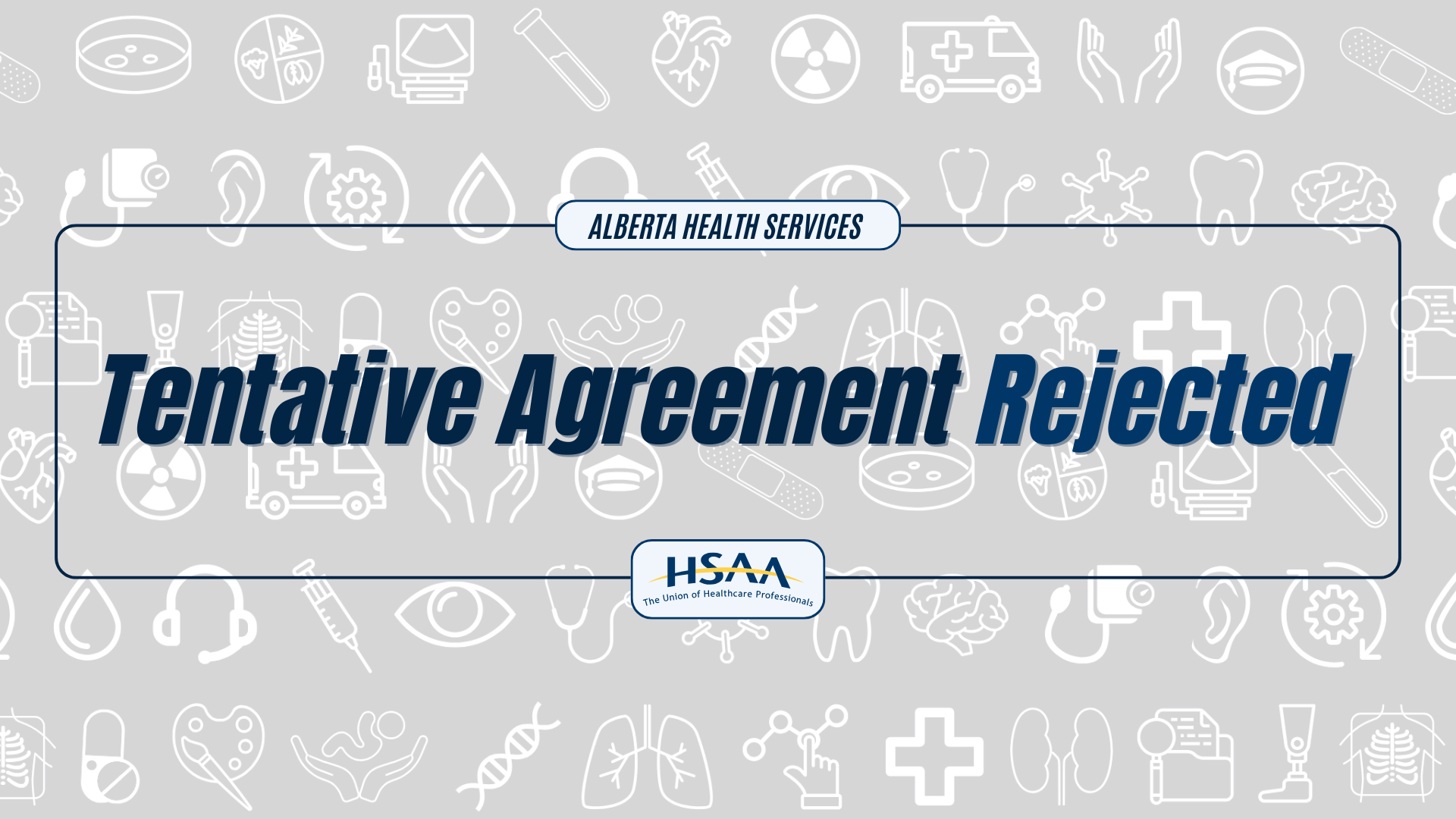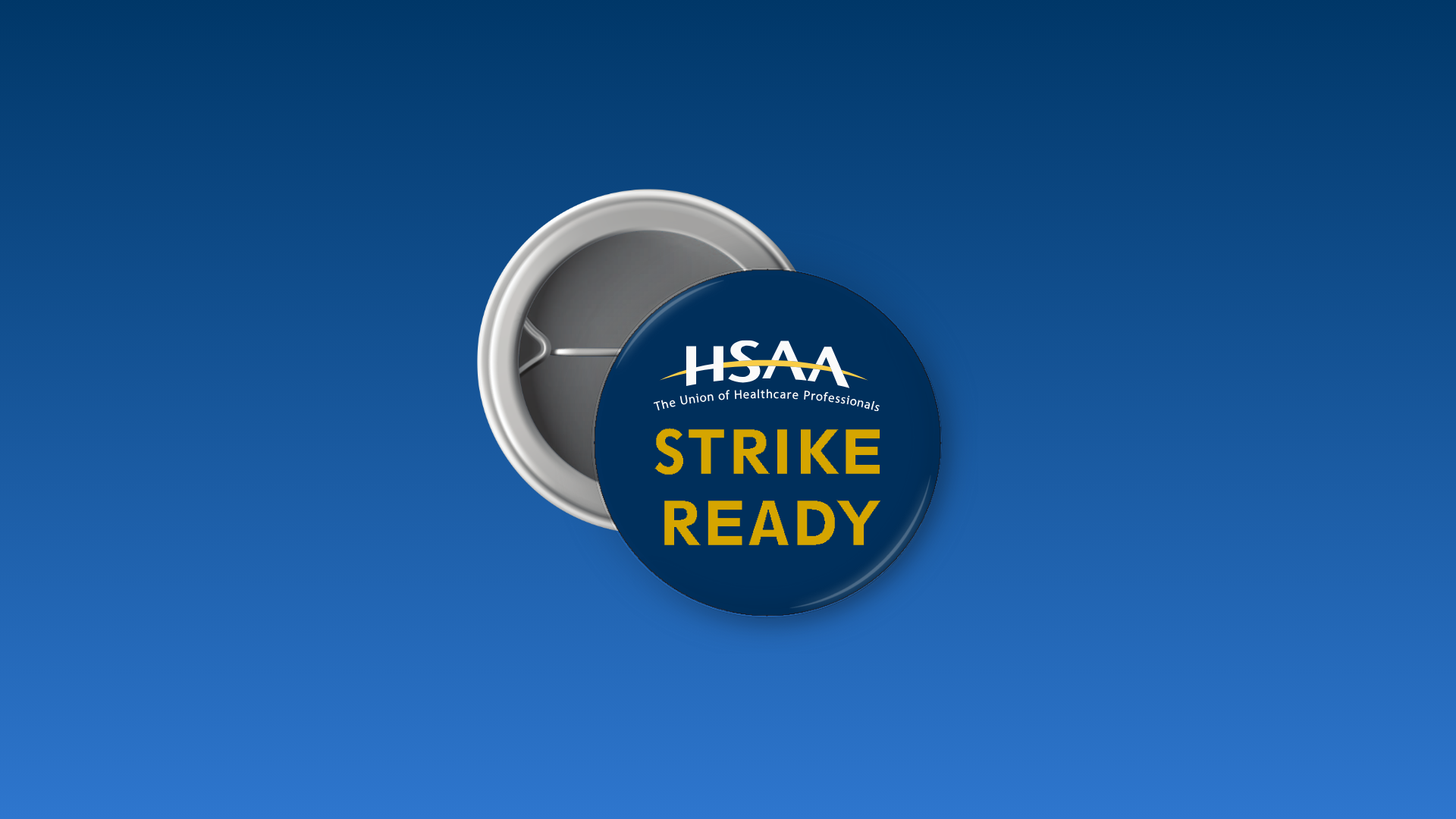FAQ: Mediation & Strikes
Have questions about what mediation or strikes? We've got answers.
Formal Mediation & Strike Preparedness
This page contains AHS-specific mediation and strike FAQ. For more general FAQ on the processes overall, make sure to visit our FAQ: Mediation, Strikes & ESAs page.
Click here for general FAQ page
AHS - Mediation
What is HSAA negotiating for at the bargaining table? What are our proposals?
Negotiations are subject to embargo as we enter formal mediation. This means we cannot share specific bargaining proposals subject to mediation.
However, HSAA is committed to telling members as much as we can without strategically compromising our position at bargaining table.
How far apart are HSAA and the employer on negotiations?
We are very far apart.
AHS is offering 10 per cent over four years. That doesn’t come close to matching inflation. In real terms, it’s a pay cut. AHS also wants to freeze wages for some members and replace real increases with one-time lump sums. That’s not a raise; it’s a way to divide us.
The professions facing wage freezes are:
- Health Information Management Professionals
- Social Workers
- Speech Language Pathologists
- Respiratory Therapists
- Pharmacy Technicians
AHS also wants concessions and rollbacks to your rights, such as:
- Ending EMS shift picks in Calgary and Edmonton.
- Changing how salary increments are calculated, so time away delays your raises.
- Cutting shift premiums by narrowing when they apply.
- Reducing rest time between shifts from 15 to 14 hours.
- Allowing on-call shifts to be cancelled without notice at all.
- Ending the ability to bank on-call time.
Our wage specific proposal is a 20 per cent wage increase over four years. We are fighting for fair increases for all members.
So far, AHS has refused our proposals for:
- More personal leave days.
- Paid leave for domestic violence.
- A clear process to address excessive workloads.
- Improved job security.
How did we get to this point in negotiations with AHS?
Your HSAA bargaining committee has been working since December of 2023 preparing for the bargaining process, supported by a team of Labour Relations Officers and our subject matter experts.
Negotiations opened formally in March of 2024 and broke down in October, 2024, after no tentative agreement could be reached. There have been 19 bargaining sessions held to try to conclude a new agreement for members employed by AHS.
The informal mediation process began at the end of November 2024 and after nine mediation meetings with the parties. On January 31, 2025, the Mediator concluded that no deal could be reached.
How do these negotiations with AHS impact other bargaining tables?
Alberta Health Services is our largest bargaining table and currently includes all HSAA members working for AHS as well as one of the newly formed health agencies (Recovery Alberta, Primary Care Alberta, Acute Care Alberta and Assisted Living Alberta).
Negotiations with Alberta Precision Laboratories (APL) and Covenant Health are both progressing slowly as these employers wait to see the outcome of negotiations with AHS.
It’s clear all three tables are subject to the same bargaining mandate set by the Government of Alberta.
Who is our mediator in informal mediation with AHS?
The mediator’s name is Deborah Howes. They are a chartered mediator with over 30 years’ experience, and former Vice-Chair of the Labour Board.
When is formal mediation scheduled to take place?
We have dates for formal mediation on June 24, 25, 26, 27, as well as July 7 and 8.
That is plenty of time to get to a deal. HSAA and your bargaining committee is 100 per cent committed to reaching a deal at the bargaining table.
How do our negotiations compare to other recent public sector negotiations?
HSAA is looking closely at other deals reached with employers related to the Government of Alberta, including The Alberta Teachers Association (ATA), The United Nurses of Alberta (UNA) and The Alberta Union of Provincial Employees, representing government workers.
The pattern for direct wage increases being offered by the government to other unions is 12 per cent over four years.
The last offer to HSAA from AHS was 10 per cent over four years.
The nurses modified wage grids and adjusted other monetary benefits to increase that overall wage. The nurses voted to ratify their deal.
The teachers just rejected the offer of 12 per cent over four years. It is important to note that teachers are not covered by essential services legislation.
Government employees with AUPE have been offered 11.5 per cent over 4 years. They held a strike vote which resulted in more than 90 per cent of workers supporting job action.
What can I do during this time, before the strike vote?
HSAA asks all members covered by the AHS collective agreement to please wear and use the provided ‘Strike Ready’ buttons, pins, pens and lanyards.
Please carefully read all emails and materials sent from HSAA to stay informed. Talk to each other, talk to your coworkers, and talk to your families about what a fair deal means to you.
When would the earliest potential strike date be?
Your Bargaining Committee is working as hard as possible to secure a fair deal in formal mediation.
Formal mediation has been scheduled for June 24, 25, 26, 27, and July 7 and 8.
How can I make sure I receive updates on the bargaining status with AHS?
Only registered members who have provided HSAA with an up-to-date email address will receive email updates when they are available. Be sure that your contact information is up to date.
AHS - Essential Services
How were staffing levels determined in the ESA?
Staffing levels have been determined jointly by HSAA and AHS through ESA negotiations. Essential Service plans are organized by site, department and/or program.
AHS provided HSAA with the full employee complement and the shifts for a seven-day period. They also provided information on what reductions—if any— will be made in the event of a job action.
No names or schedules were provided, so we do not know who works what shift—that information isn't provided until we are in a strike position.
Together with the employer, we looked at which services would need to continue, what level of service was essential, and then how many employees would be required to achieve that service level.
How many members under the AHS bargaining unit will be deemed essential and how many will be able to join the picket line?
Roughly 45 per cent of the AHS bargaining unit will be deemed essential and at a minimum will be working during a strike or lockout. This means approximately 55 per cent of members will be eligible to strike.
How will scheduling of essential service workers be handled?
When an ESA agreement comes into effect, HSAA is required to assume responsibility for scheduling designated essential workers starting in the first week. Typically, this role falls to HSAA staff. However, members may be designated to assist in this role. The Essential Services Scheduler’s duties include:
- Scheduling for a site, department, or classification depending on the size of the site that is on strike.
- Being the first point of contact if an employee that is scheduled to work requires time off due to illness and arrange for coverage of that shift.
- Ensuring fair and equitable distribution of all ESA work.
- Immediately reporting to Labour Relations Staff if there are any issues with the staffing levels as laid out in the ESA.
The details of how schedules will be decided and communicated will be shared with members closer to the start of a strike or lockout. This approach helps protect our strategy for a successful job action and supports membership solidarity.
How are staffing assignments organized in the ESA?
The staffing plans are organized by AHS’ financial coding system, which, in a majority of cases, is broken down by department. However, some plans are split even further, dividing departments into functional groups and/or by classification. Each plan is different and needs to be considered separately.
Would the ESA be split into 8- or 12-hour shifts?
This is wholly dependent on the normal working hours of those covered by that individual plan. In some cases, shifts could be reduced.
Can you clarify how on-call work is handled with ESAs?
This depends on the situation. If on-call was already in use and deemed essential, it will continue to be applied in the same way. However, if on-call was not previously used, its application during job action may differ. In some cases, certain plans have been reduced to on-call only. For the AHS agreement, Article 13 On-Call Duty does not apply however the Clause 9.03 of the ESA contains specific provisions for those DESWs assigned to on-call.
What happens if someone that is scheduled to work under an ESA calls in sick? How does the union fill that shift?
During a strike or lockout, the union is responsible for scheduling, including covering sick calls. If a member scheduled to work under the ESA calls in sick, the union will follow a process for filling the shift. This process will be communicated to members in advance.
Can essential workers be redeployed to a different unit or area on-site that is not their regular work location in order to fill a required role?
Members will not be scheduled to work at a site or work a shift that they are do not regularly scheduled for.
For rural members who work in multiple service streams (e.g., acute care, continuing care, outpatient) is there a potential of a partial FTE as essential service? (like needing to cover acute care but not outpatient).
Yes, there is potential of a partial FTE to be deemed and an essential service worker.
Are essential workers expected to work their full 12 hours as opposed to the 7.75 hours expected on the picket line?
Yes, essential service workers will be expected to work the full length of their shift.
Does the essential worker agreement account for continuity of care?
Yes. Where discontinuing services would lead to imminent patient harm, there will be higher staffing levels for that functional work area.


